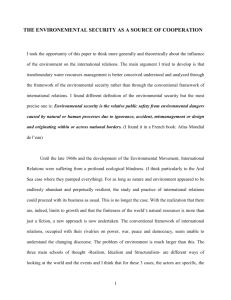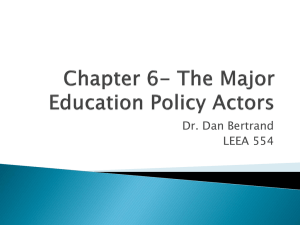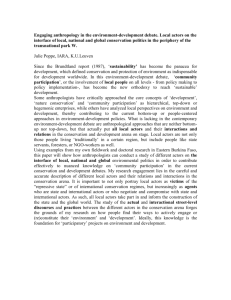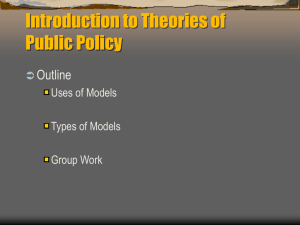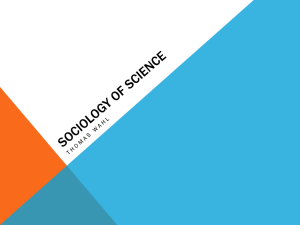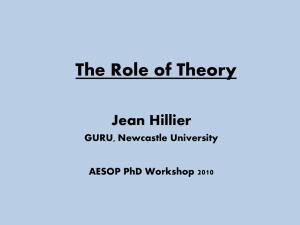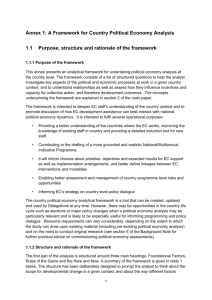U.M. Professor Dr. Saha`s PowerPoint presentation on the structure
advertisement
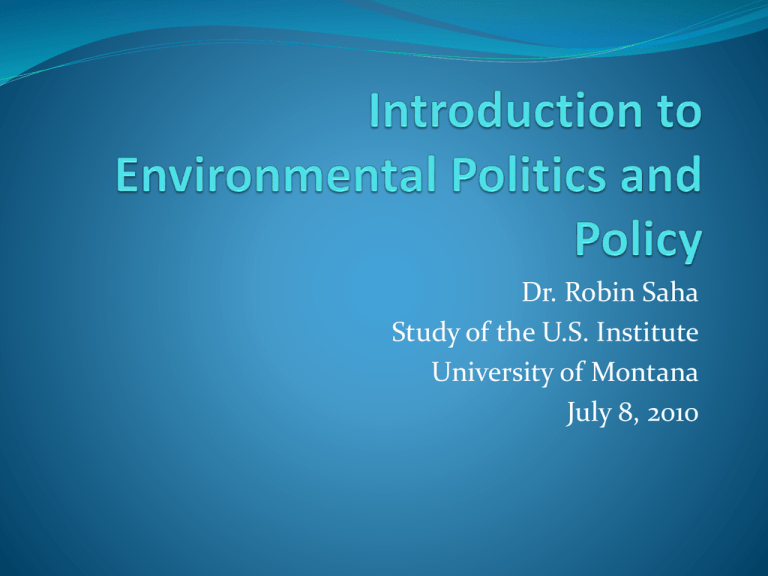
Dr. Robin Saha Study of the U.S. Institute University of Montana July 8, 2010 Topics Features of U.S. political system Role of state government Definitions – policy and power – sources of power Public policy theories Historic periods of U.S. environmental policy Major environmental policies in the U.S. Policy process / policy stages / policy cycle Policy “actors” – strategies and tactics to influence decision makers Policy typology Group activity (if we have time) Features of U.S. Political System 1. Democratically-elected leaders 2. High level of citizen participation 3. Constitutional separation of powers among the executive, legislative, and judicial (3) branches – horizontal fragmentation A. Federalism – federal supremacy over state government (hierarchy or levels of governmental authority), constitutionally-reserved state powers, with local powers deriving from state authority – vertical fragmentation B. Resulting in dispersed and ever-contested power 4. Relatively open government 5. Primacy of individual (and corporate) freedom and private property rights 6. Constitutional guarantee of freedom of belief, expression, and the press, and rights to associate with others 7. Powerful organized interests 8. Short terms for elected officials 9. Campaign financing allowed 10. Enduring two-party system To read more, see: http://bensguide.gpo.gov/9-12/index.html Public Policy Represents government’s attempt to address and/or solve perceived public problems and: 1. Includes the intentions, actions, and effects of government. 2. The intentions may or may not be publicly stated. 3. Any formal declarations such as laws, regulations, executive orders, and court decisions are public policy. Government Policy Types Corresponding to the U.S. government structure and the three branches of government Legislative policy – policies enacted by Congress, state legislatures, and city councils Administrative policy – executive branch policies established by the president, state governors, city mayors and their political appointees, and by federal and state agencies and city offices (bureaucracies) Judicial policy – policies established by the federal and state courts Role of State Government in Environmental Policy Implement federal environmental laws and programs through U.S. Environmental Protection Agency (EPA) Must have state legislation modeled after federal legislation (must be as or more stringent than federal laws) In 1980s and 1990s, developed capacity to implement environmental and natural resource laws, accompanied by growth in the state environmental bureaucracy (number and size of agencies) States have tended to follow federal leadership Some states (esp. California) are environmental policy innovators – can provide good ideas for federal (national) policy State can be important testing grounds for new policy approaches Environmental Policy “… comprises a diversity of governmental actions that affect or attempt to affect environmental quality or the use of natural resources …. We cannot expect to locate environmental policy in any single decision or statute. Rather it is the aggregate of statutes, regulations, and court precedents, and the attitudes and behavior of public officials charged with making, implementing, and enforcing them. Policies may be tangible or largely symbolic … they may nevertheless bring about important environmental changes over time by influencing public beliefs and organizational values and decision making.” – Michael Kraft (2003). Public Policy Theories (also see Vaughn book, Ch. 3) Elite theory Policy reflects the values, preferences, and judgments of the governing elites Elites include powerful government officials, foundations, corporate executives, and influential professionals such as scientists, doctors, lawyers Focuses on the role of leaders and leadership Assumes elites influence (manipulate?) “the Masses” rather than the other way around Movement of non-elites into elite positions is slow and controlled to maintain stability Public Policy Theories (continued) Group Theory Policy is the result of the continuous struggle among interests groups made up of individuals or organizations with common beliefs, values, and goals Groups differ in the amount and type of resources (political capital), and thus their influence over other groups and policy makers Government acts as the neutral arbitrator. Different groups may cancel out or check the power of other groups Policy makers and the political system manage group conflict by establishing rules of struggle, arranging or imposing compromises, and balancing interests Policy is the result of the balancing of power between competing groups and represents an equilibrium point Power Power is ability to reward other actors for doing what one wants or to penalize or punish them for working against ones interests Public Policy Theories (continued) Government Politics Model A “middle ground” theory that views policies as the result of the influences of elites and organized interest groups Assumes that policy decisions are the result of the competition, bargaining, and compromise among a diverse set of policy actors Policy actors have unique interests, resources, and strategies they use to advance their interests Actors include government decision makers (more on policy actors later) Political process leads to incremental policy making, i.e., modest new policies and small changes to existing ones, The political system is most likely to overcome these tendencies in times of major crises Non-governmental policy actors Interest groups (e.g., NGOs, professional associations, unions – organized labor), their lobbyists, and members Corporations, industry trade associations, and their lobbyists Political Action Committees (PACs) The Media Scientists and scientific bodies Think tanks (policy and legal research institutes) Celebrities General public, individual citizens, and public opinion Factors Related to Interest Group Influence Size of group membership Ability to mobilize members into action Monetary and other resources, including technical and scientific capabilities Skill of its leadership Social status and prestige of organization and leaders Salience of policy issue to mission of the organization Presence of absence of competing organizations Attitudes of public officials (decision makers) toward group and access to decision makers Site of decision making in the political system Historical Periods of U.S. Environmental Policy (from Vaughn book, Ch. 1) Colonial period: 1607 to 1900 Progression reforms and conservationism : 1900 to 1945 Recreation and the age of ecology: post-WWII to 1969 Earth Days and deregulation: 1970 to 1992 Global awareness and gridlock: 1993 to 2000 Rollback: 2000 to 2009 Major Public Lands and Conservation Policies Yellowstone National Park Established (1872) Yosemite National Park Established (1890) Forest Reserve Act of 1891 Forest Management Act of 1897 Antiquities Act of 1906 Multiple Use and Sustained Yield Act of 1960 Wilderness Act of 1964 National Environmental Policy Act of 1970 (NEPA) Endangered Species Act of 1973 (ESA) National Forest Management Act of 1976 (NFMA) Federal Land Policy and Management Act of 1976 (FLPMA) Alaska National Interest Land Conservation Act of 1980 (ANILCA) Health Forests Protection Act of 2003 (HFPA) Major U.S. Environmental Policies (see separate handout) Clean Air Act of 1970 Federal Water Pollution Control Act Amendments of 1972 (Clean Water Act) Federal Insecticide, Fungicide, and Rodenticide Act (FIFRA) of 1972 Safe Water Drinking Act (SDWA) of 1974 Toxic Substances Control Act (TSCA) of 1976 Resource Conservation and Recovery Act (RCRA) of 1976 Comprehensive Emergency Response Compensation and Liability Act of 1980 (CERCLA) Superfund Amendments and Reauthorization Act of 1986 Clean Air Act Amendments of 1990 Policy Process Stages (Policy Cycle) (also see Vaughn book, Introduction) Moving from problem to solution: Problem Identification/Definition Agenda Setting Policy Formulation Policy Adoption/Legitimation Policy Implementation (and budgeting) Policy Evaluation Policy Change/Evolution Policy Termination or Problem Resolution Public Policy Typology (and associated politics) 1. Distributive – grants, programs, and services that distribute resources or projects (often “pork barrel”) with only “winners” (in the most narrow sense) • College student grants • Agricultural subsidies • Highways and bridges • Parks and other amenities 2. Redistributive – having goal of redistributing wealth, income, or opportunity to compensate for market or government failures, with clear “winners” and “losers” • Welfare • Taxes • Social security • Affirmative action 3. Regulatory – restricting individual or groups conduct to be within acceptable bounds with general societal benefits and costs to specific industries • Consumer protection • Workplace health and safety • Environmental • Licensing, anti-trust, etc. Instruments of Public Policy 1. Regulation 2. 3. 4. 5. • Laws or decrees requiring citizens or corporations to do something or not do something • Sanctions imposed for non-compliance Governmental Management • Direct provision of services or programs to the public, private industry, or other levels of government • Includes management of natural resources and environmental quality Taxing and Spending • Mechanism to regulate and provide services • Also used to create incentives to encourage or discourage certain behaviors and activities, such as smoking Market Mechanisms • Involve decisions to intervene or not into the market place • Can include subsidies and other incentives, or disincentives, to encourage or discourage certain behaviors and activities Education, Information, and Persuasion • Attempts to persuade people or businesses to behave a certain way Incentive-Based Regulation Rather than using penalties for non-compliance, incentive- based regulation encourages individuals, government entities, and corporations to voluntarily perform desirable behaviors by providing incentives, usually economic (market-based incentives) though sometime rewards and recognition or relief from future regulation are used. Examples: Cap and trade provisions for SO2 in Clean Air Act of 1990; similar proposed programs for reducing CO2 emissions and hazardous air pollutants such as mercury; tax credits for alternative energy; Candidate Conservation Assurances and Agreement (CCCAs) under the Endangered Species Act; beverage container deposits to encourage recycling; EPA’s Energy Star program to encourage energy conservation. Activity In your country groups Pick an environmental problem or issue Think of policy instruments (regulation; gov’t mgt., taxing & spending; market mechanisms; education, information, & persuasion) that can address or help solve the problem For each policy instrument identify the level of government and policy actors that should be involved Discuss obstacles or challenges to policy adoption Report back to full group
